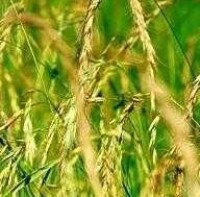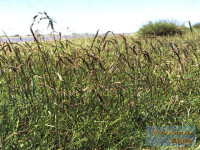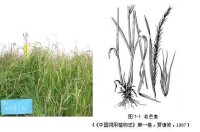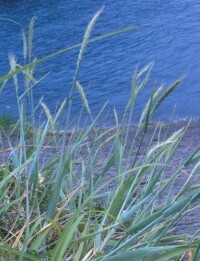披鹼草屬
披鹼草屬
披鹼草屬(Elymusspp.)是禾本科(Gramineae)小麥族(Triticeae)重要的一個屬,主要分佈在歐亞大陸和北美洲北部。其垂直分佈從海拔幾米的海灘一直到海拔5200m以上的喜馬拉雅山區。披鹼草屬植物的多數物種為草原和草甸的重要組成成分,許多種類是飼用價值較高的優良牧草。

披鹼草
屬拼音名:pijiancaoshu
屬拉丁名:Elymus
中國植物志:09(3):6
披鹼草屬Elymus牧草分佈廣泛,種類繁多,廣義的披鹼草屬包括近150個種,而在我國,則比較接受狹義披鹼草屬的概念,即有12餘種。披鹼草屬牧草為中生-旱中生多年生優良牧草,是草原和草甸的重要組成部分,飼用價值極高。該屬是禾本科小麥族中非常重要的一個類群,它具有麥類作物所缺乏的抗病、抗蟲、抗旱、耐鹽等優良抗逆基因,是現代麥類育種的重要種質資源。
垂穗披鹼草
短芒披鹼草
肥披鹼草

披鹼草屬
加拿大披鹼草
老芒麥
麥薲草
毛披鹼草
披鹼草
披鹼草(原變種)
披鹼草屬
青紫披鹼草

披鹼草屬
無芒披鹼草
圓柱披鹼草
紫芒披鹼草
以我國9種披鹼草屬(Elymus L.)的40個居群為材料,採用形態學、等位酶和微衛星3種標記對28個形態特徵、7個等位酶位點和l1對SSR引物進行遺傳多樣性分析。結果表明:不同居群的披鹼草間形態差異顯著;不同種、居群和形態特徵變異規律也有所不同。旗葉與穗基部長度、生長速度(幼苗一分櫱)、小穗柄、植株絨毛分級在種內變異較大,而穗的形狀、穗節數、株高和內稃的變化較為穩定。聚類分析結果表明:披鹼草(E.dahuricus Turcz.)、圓柱披鹼草(E.cylindri—CUS(Franch.)Honda)、紫芒披(E.purpuraristatus C.P.Wang et H.L.Yang)變異很大,垂穗披鹼草(E.nutans Griseb L.)和老芒麥(E.sibiricus Linn.)的居群按種歸類比較清晰等位酶分析結果表明,在4O個居群材料中7個位點發現了22個等位基因。在屬的水平上多態性位點百分數為87.5 ,居群內平均多樣性指數(Hs)為0.0830,居群間平均多樣性指數(Dst)為0.2149,所有多態性位點的遺傳分化係數(Gst)為0.7213。在該屬中,遺傳多樣性(HP)和Shannon’S信息指數(He一0.2974;I:0.4565)最大水平上反應了披鹼草居群之間的變異。在種的水平上遺傳多樣性和Shannon’S信息指數分別為0.0800~0.2528和0.
1173~0.3769,而居群內二者分別在0.016O~0.1680和0.0250~0.2433範圍內。在屬內,遺傳分化的分配量依次為種間(38.9 )、種內居群間(33.2 )和居群內個體之間(29.8 )。居群之間基因流(Nm)很低,為0.1932。屬於同一種的居群基本能聚類在一起,同時和地域之間亦有明顯的關係。9種披鹼草屬植物雖然不是按照穗的形狀(披鹼草組)(Sect.Turczaninovia(Nevski)Tzve1.)和老芒麥組(Sect.Elymus))分為兩組,但屬於披鹼草組和老芒麥組內的披鹼草關係親近。以垂穗披鹼草為例,海拔是影響遺傳差異最重要的因素,其次是地理位置(緯度和經度)。l1個多態性微衛星位點發現有1~8個等位基因,共檢測出38個等位變異,平均3.5個等位變異。來自於披鹼草的微衛星引物平均4.5個,而來自於小麥的2.2個,披鹼草的特異SSR引物在反應遺傳多樣性方面具有更好的作用和效果。位點ECGA22、ECGA114、EAGA51和WMS43遺傳變異信息含量比較高,對於構建披鹼草高密度的微衛星種(品種)指紋是很好的選擇。種內和種間的遺傳多樣性變異結構,多個引物具有很好的一致性,大多數基因多樣性存在於種內,佔總變異的75.74%。無論等位酶還是微衛星標記,在青藏高原地區都擁有遺傳豐富的披鹼草資源。在披鹼草種的多樣性指數變化也很大,基因多樣性和Shannon’S信息指數變化範圍分別在0.1622~0.3619和0.2248~0.5318。相似性和聚類分析結果顯示,對居群水平大致可按種來進行劃分。SSR標記對不同披鹼草居群的聚類和材料間的親緣關係和地域分佈有較好的一致性。披鹼草的9個種並沒有分成幾個明顯的組,而以老芒麥和青海披鹼草(E.geminatus L.)最近,其次是披鹼草和紫芒披鹼草親緣關係,垂穗披鹼草和短芒披鹼草(E.breviaristatus(Keng)Keng F.)也相對較近。地理位置(緯度和經度)是影響垂穗披鹼草居群微衛星遺傳差異最重要的因素,其次是海拔。

披鹼草屬
Candidate:YAN Xue—bing Advisors:ZHOU H e,W AN G Kun (1.Grassland Institute of China Agriculture University,Beijing 100094,China; 2.Zhengzhou College of Animal Husbandry,Zhengzhou,Henan Province 450008,China) The genetic diversities of 40 populations of 9 Elymus species from China were determ ined, using morphology,allozyme and microsatellite markers for 28 morphological traits,seven allozyme loci and eleven pairs of microsatellite primers. M orphological traits differed greatly among populations and variation trends also deviated within species and populations. The distance between the flag leaf and the spike of a plant 。the growth rate during the seedling to the tillering stage,the rachilla and the plant villus grade varied species from species'though the spike shape,the spike pitch number,the plant height,and the palea changed unvaryingly. Dendrogram of relationships showed that,though E. dahuricus Turcz.,E.cyli d,-ic (Franch.)Honda,and E·purpurari, status C.P.W ang et H. L. Yang varied to a great extent,populations of E. t日 Griseb.L..and E.sibiricus Linn. clearly clustered together within the species. A llozym e data indicated that, 7 allozyme loci were encoded by 22 alleles across 40 populations . The polym Orphic loci percentage was 87.5 at genus leve1.M ean of diversity index were 0 . 0830 within populations 【Hs)and 0.2149 among populations (Dst).Coefficient of genetic variation across all polymorphic loci was 0.7213.Genetic diversity(H e)and Shannon’s information index ( )had the biggest variation values(H 一0 .2974;一0·4565)among populations of Elymus genus,ranging from 0. 0800 to 0.2528 and 0.1 173 to 0.3769 at species level,from 0.01 60 to 0.1 680 and 0.0250 to 0 . 2433 within populations,respectively.of the total genetic variation of Elym us genus, 38.9 existed among species, 33. 2% amidst populations within the species'and 29·8 am id individuals within a population. Gene flow among the populations was sluggish.a mere 0·1932.Populations belonging to the same species norm ally clustered together,and the dendrogram was obviously related to the geographical origins. Though 9 Elymus species were not divided by spike morphology into two groups:Sect.Turczaninovia (Nevski)Tzve1.,and Sect. Ety,,2 ,all the E ,,2 species in the two Sects·showed close relationship.Take E.nutans Griseb . L.for an instance,elevation was the most imDortant factor influencing the plant’s genetic difference,while the geographical site(1atitude and longitude)played only a secondary role. M icrosatellite data indicated that there were 1~ 8 alleles in the ll polym orphic SSR loci ,and 38 multiDle alleles,were detected,averaging 3.5 m ultiple alleles. M icrosattelite primers developed from E/y “ sDecies averaged 4·5 alleles,higher than that of wheat of an average of 2 . 2,indicating that m icrosatellite primers developed from Elymus species functioned better in determining its genetic diversity . Loci ECGA22、ECGA 1 1 4、 EAGA5 1 and W M S43 transferred more inform ation on the genetic variation , helping to the construction of fingerprint of Elymus species. Primers consistently indicated that 75 . 74 of the variation existed am ong populations within the species. Tibetan plateau was genetically resourceful of E ,2 species based on bo .thallozyme and SSR m arkers.Gene diversity and Shannon’s inform ation index at species level varied greatly from 0·1622 to 0·3619 and 0.2248 to 0.5318, respectively . Similarity and dendrogram of clustering among populations showed consistence with their species and geographical origins. Nine E species were not clearly divided into different groups,though E . sibiricus and E.gemi at related most closely,E. d日h ,-ic and E·pu uraristatus came next. So were E.nutans and E . breviaristatus Geographical site (1atitude and longitude)was the most Im portant factor influencing the genetic difference. Elevation came next .